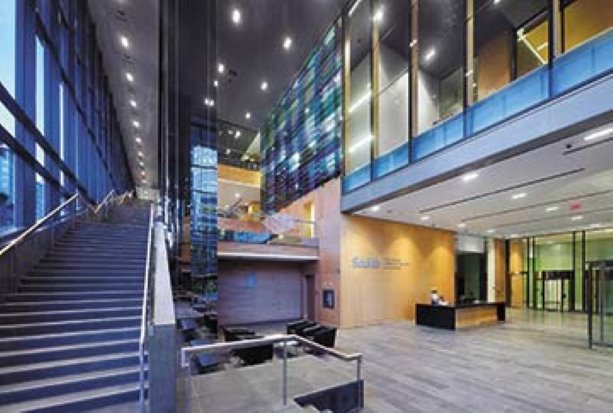The Peter Gilgan Centre for Research and Learning has opened at The Hospital for Sick Children (SickKids) in Toronto, bringing 2,000 researchers, trainees and staff previously dispersed throughout six buildings under one roof.
At 778,000 square feet, the 21-storey laboratory designed by Diamond Schmitt Architects is believed to be the largest child health research tower in the world and among the largest laboratories in the high-rise form.
Contractor was EllisDon.
Situated on a dense urban site, the building will serve as a centre of excellence for SickKids to further its commitment to advancing pediatric research.
“With state-of-the-art laboratories, learning facilities and multi-level interactive spaces, the entire building is designed to enhance collaboration and interaction,” Donald Schmitt, principal, with the design firm, said in a release.
Six thematic research neighbourhoods each have open two- and three-storey collaborative spaces connected by stairs. These working lounges have kitchenettes, white boards, soft furnishings and “incomparable” views of the city through glazing with high transparency.
Diamond Schmitt said these “innovative and dramatically arranged” spaces provide gathering points where scientists, clinicians and students can share information and fuel innovation.
The curvilinear form of the stacked bay windows differentiates these spaces as a defining feature of the façade and the curvilinear form continues inside to create a dynamic hub space.
Working closely with the hospital, the architects sought to demystify the role of medical research by bringing it to street level. Conference and education facilities populate a learning concourse on the ground floor through level three. Teleconferencing and distance learning technologies allow for information exchange around the world facilitated in a 250-seat auditorium.
To further overcome the constraints of a tall building silo culture, the 17 floors of labs are open and flexible for reconfiguration, where modular mobile benching converts from web lab to dry lab as research demand requires.
“This accommodates scientists and researchers from different disciplines to interact and who normally wouldn’t rub shoulders,” said Dr. Janet Rossant, Sick Kids’ chief of research.
“Not only will cell biologists, computer scientists and geneticists work side by side in the labs, researchers will also meet over coffee in the neighbourhoods’ open, light-filled atriums. Those spontaneous meetings present incredible opportunities to share information and promote new discoveries in children’s health.”
An abundance of natural daylight is just one element that puts this green facility on track for LEED Gold certification for sustainable design. Fully 80 per cent of the tower’s high performance glazed enclosure is covered in a horizontal graduated ceramic frit for thermal control that maximizes daylight harvesting.
Natural light penetrates to over 90 per cent of the program areas and most of the labs enjoy two aspects of light with windows facing both north and east, or south and west.
The Gilgan Centre takes a whole-building approach to sustainable design in five key areas of human and environmental health:
— Sustainable site development with 75 per cent waste diverted from landfills;
— Water efficiency produces a 50-per-cent reduction in water use;
— Energy efficiency measures will bring a 38-per-cent reduction in energy use;
— Materials selection with 22.5-per-cent recycled content for new construction materials; and
— Improved indoor environmental quality from low VOC-emitting products.
The Peter Gilgan Centre for Research and Learning is connected to the hospital by a pedestrian bridge. It forms the eastern gateway to Toronto’s Discovery District of health care and biomedical research.
Funding and support for the $400 million project was provided by the Canada Foundation for Innovation, three levels of government, and a $200 million fundraising campaign with a lead donation of $40 million from Peter Gilgan.
The project team included: mechanical and electrical engineers HH Angus and Associates Ltd.; civil engineers MMM Group Ltd.; LEED consultant CDML Consulting Ltd.; building sciences professionals Yolles, a CH2M HILL company; landscape architects du Toit Allsopp Hillier; energy engineers Integral Group; and commissioning authority Stantec Consulting Ltd.




Recent Comments
comments for this post are closed